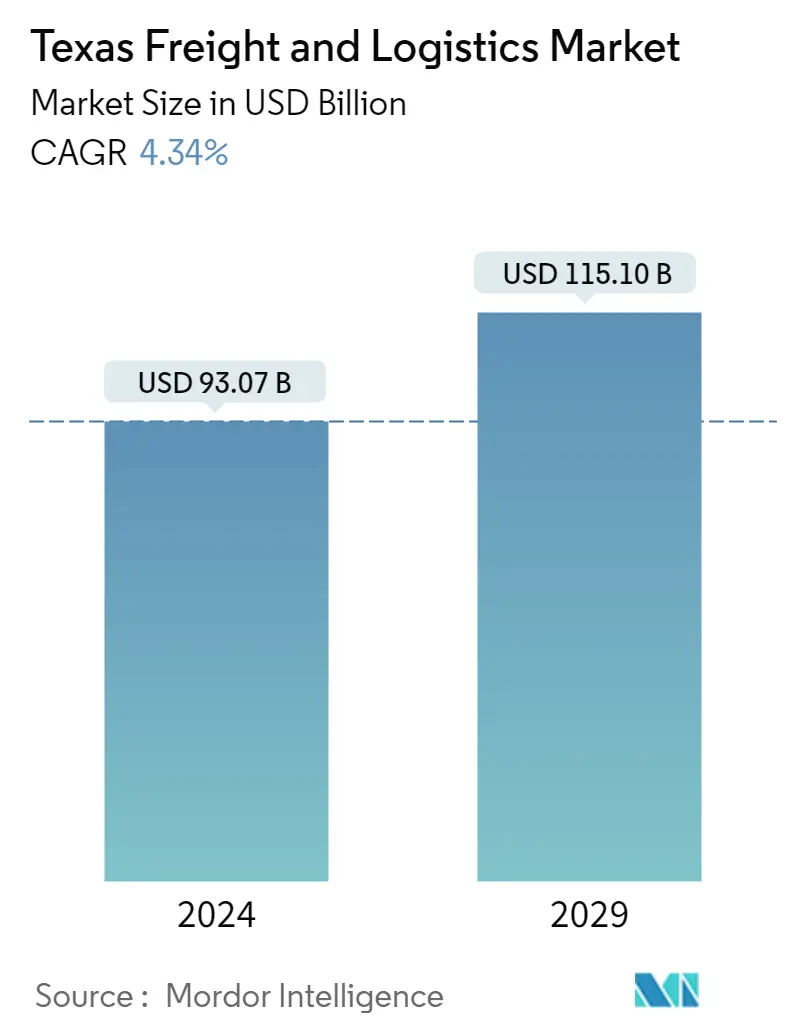Market Size of Texas Freight and Logistics Industry

| Study Period | 2019-2028 |
| Base Year For Estimation | 2022 |
| Market Size (2023) | USD 89.20 Billion |
| Market Size (2028) | USD 110.31 Billion |
| CAGR (2023 - 2028) | 4.34 % |
| Market Concentration | Low |
Major Players
*Disclaimer: Major Players sorted in no particular order |
Need a report that reflects how COVID-19 has impacted this market and its growth?
Texas Freight And Logistics Market Analysis
The Texas Freight and Logistics Market size is expected to grow from USD 89.20 billion in 2023 to USD 110.31 billion by 2028, at a CAGR of 4.34% during the forecast period (2023-2028).
The market is driven by the geographical placement of the state and the enormous transportation of goods within and out of the country that happens via Texas. Furthermore, the market is also driven by a large number of ports present in Texas.
- Texas' enormous size is a well-known fact that Texans worldwide take pride in. Only the state of Alaska is physically larger at 268,597 square miles. But Texas can claim something that even Alaska cannot: it is a major international shipping hub. The state has 29 ports of entry, including seaports (Beaumont, Corpus Christi, Freeport, Galveston, Houston, and Port Arthur), two international airports (Dallas/Fort Worth and George Bush), three land ports (El Paso, Hidalgo, and Laredo), and Intermodal Ports (Beaumont, Corpus Christi, Freeport, Galveston, Houston, and Port Arthur). Texas ports support nearly USD 450 billion in economic activity in the state and USD 1 trillion in national economic activity as international trade hubs.
- Texas shares a border with Mexico, America's second-largest trading partner. Texas is better positioned for Asian trade after the Panama Canal expansion, especially given the bottlenecks at West Coast ports. The multimodal freight transportation network supports agriculture, energy, manufacturing, defence, construction, distribution and other key industries throughout Texas. The multimodal network connects Texas businesses to domestic and international supplies, facilities, and markets. The Texas freight and logistics industry is expected to have a bright outlook in 2022, with several new trends dominating the industry.
- Texas leads the 50 states in total lane miles and has four of the top eight cities in terms of lane mileage per capita. Texas road policy is full of innovation, from well-designed private toll roads to state researchers experimenting with a "freight shuttle" system in which trucks are moved along conveyor-type medians separated from regular traffic. Texas' transportation and logistics systems are cutting-edge and forward-thinking, and it can be expected that the state will continue to lead the way in logistics and shipping support for Asian, Hispanic, and European e-commerce markets. Considering Texas is the most important state for international trade, it consists of a vast network of warehouses, manufacturing plants, roads, rail, ports, and other infrastructure. As long as Texas remains an open economy and continues to grow, and as long as the United States commits to free trade, the state will be ground zero for advanced logistics.
Texas Freight And Logistics Industry Segmentation
Freight and logistics refer to the transportation of goods in the domestic and international markets via various modes, including air, rail, and roadways. A complete background analysis of the Texas Freight and Logistics Market, including the assessment of the economy and contribution of sectors in the economy, market overview, market size estimation for key segments, and emerging trends in the market segments, market dynamics, and geographical trends, and COVID-19 impact is included in this report.
The Texas Freight and Logistics Market are segmented By Function (Freight Transport, Freight Forwarding, Warehousing, and Value-Added Services) and By End User (Construction, Oil and Gas and Quarrying, Agriculture, Fishing, & Forestry, Manufacturing and Automotive, Distributive Trade, and Other End Users). The report offers market size and forecast values (USD billion) for all the above segments.
| By Function | ||||||
| ||||||
| Freight Forwarding | ||||||
| Warehousing | ||||||
| Value-added Services |
| By End-User | |
| Construction | |
| Oil and Gas and Quarrying | |
| Agriculture, Fishing, and Forestry | |
| Manufacturing and Automotive | |
| Distributive Trade | |
| Other End Users |
Texas Freight and Logistics Market Size Summary
The Texas Freight and Logistics Market is anticipated to see robust growth in the coming years. This growth is driven by the state's geographical location and the significant transportation of goods within and out of the country via Texas. The large number of ports present in Texas further fuels the market. Texas' role as a major international shipping hub, its advantageous position for Asian trade following the Panama Canal expansion, and its extensive transportation network all contribute to the positive outlook for the Texas freight and logistics industry. The market trends in Texas Freight and Logistics involve an increase in value-added services and a rise in cross-border road freight. Retailers are adapting their sales strategies to accommodate the growing trend of online shopping and social commerce, leading to changes in warehouse, distribution center, and fulfillment logistics management. The trucking industry's importance in the freight services sector cannot be overstated, especially in Texas, which is experiencing an economic boom. The industry is also evolving, with an increasing number of women entering the profession. The Texas freight and logistics market is fragmented, with a large number of local players, but major international players are expected to try and consolidate the market to gain a higher market share.
Explore MoreTexas Freight and Logistics Market Size - Table of Contents
-
1. MARKET INSIGHTS DYNAMICS
-
1.1 Current Market Scenario
-
1.2 Market Overview
-
1.3 Market Dynamics
-
1.3.1 Drivers
-
1.3.2 Restraints
-
1.3.3 Opportunities
-
-
1.4 Value Chain / Supply Chain Analysis
-
1.5 Porter Five Forces
-
1.5.1 Threat of New Entrants
-
1.5.2 Bargaining Power of Buyers/Consumers
-
1.5.3 Bargaining Power of Suppliers
-
1.5.4 Threat of Substitute Products
-
1.5.5 Intensity of Competitive Rivalry
-
-
1.6 Government Regulations and Initiatives
-
1.7 Insights into Freight Rates
-
1.8 Insights into Impact of Ecommerce
-
1.9 Insights into Major Ports
-
1.10 Insights into Multimodal Freight Network
-
1.11 Impact of COVID-19 on the Market
-
-
2. MARKET SEGMENTATION
-
2.1 By Function
-
2.1.1 Freight Transport
-
2.1.1.1 Road
-
2.1.1.2 Rail
-
2.1.1.3 Sea and Inland
-
2.1.1.4 Air
-
-
2.1.2 Freight Forwarding
-
2.1.3 Warehousing
-
2.1.4 Value-added Services
-
-
2.2 By End-User
-
2.2.1 Construction
-
2.2.2 Oil and Gas and Quarrying
-
2.2.3 Agriculture, Fishing, and Forestry
-
2.2.4 Manufacturing and Automotive
-
2.2.5 Distributive Trade
-
2.2.6 Other End Users
-
-
Texas Freight and Logistics Market Size FAQs
How big is the Texas Freight and Logistics Market?
The Texas Freight and Logistics Market size is expected to reach USD 89.20 billion in 2023 and grow at a CAGR of 4.34% to reach USD 110.31 billion by 2028.
What is the current Texas Freight and Logistics Market size?
In 2023, the Texas Freight and Logistics Market size is expected to reach USD 89.20 billion.
